Mercedes-Benz
Page 37
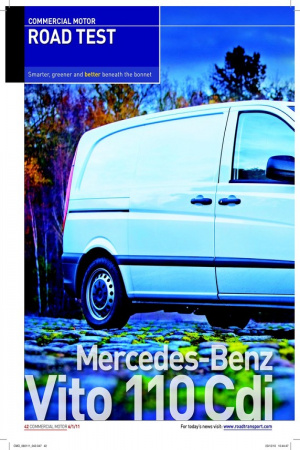
Page 39
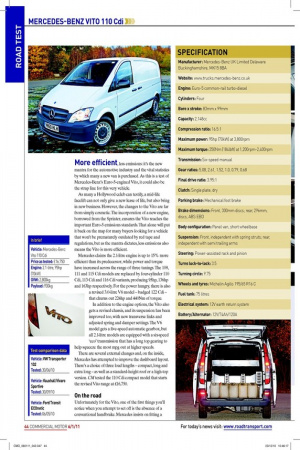
Page 40
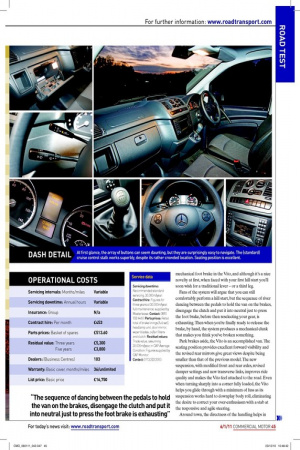
Page 41
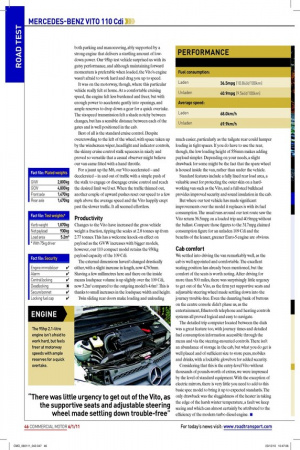
Page 42
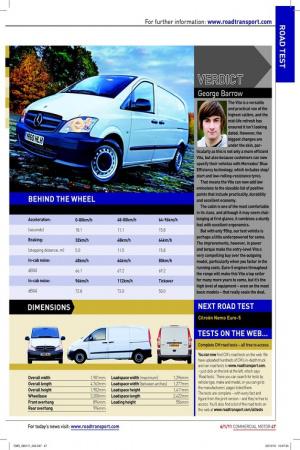
If you've noticed an error in this article please click here to report it so we can fix it.
to 110Cdi
More eficient, less emissions: it’s the new mantra for the automotive industry and the vital statistics by which many a new van is purchased. As this is a test of Mercedes-Benz’s Euro-5-engined Vito, it could also be the strap line for this very vehicle.
As many a Hollywood celeb can testify, a mid-life facelift can not only give a new lease of life, but also bring in new business. However, the changes to the Vito are far from simply cosmetic. The incorporation of a new engine, borrowed from the Sprinter, ensures the Vito reaches the important Euro-5 emissions standards. That alone will put it back on the map for many buyers looking for a vehicle that won’t be prematurely outdated by red tape and regulations, but as the mantra dictates, less emissions also means the Vito is more eficient.
Mercedes claims the 2.1-litre engine is up to 15% more eficient than its predecessor, while power and torque have increased across the range of three tunings. The 109, 111 and 115 Cdi models are replaced by four-cylinder 110 Cdi, 113 Cdi and 116 Cdi variants, producing 95hp, 136hp and 163hp respectively. For the power hungry, there is also a revised 3.0-litre V6 model – badged 122 Cdi – that churns out 224hp and 440Nm of torque.
In addition to the engine options, the Vito also gets a revised chassis, and its suspension has been improved too, with new transverse links and adjusted spring and damper settings. The V6 model gets a ive-speed automatic gearbox, but all 2.1-litre models are equipped with a six-speed ‘eco’ transmission that has a long top gearing to help squeeze the most mpg out at higher speeds.
There are several external changes and, on the inside, Mercedes has attempted to improve the dashboard layout. There’s a choice of three load lengths – compact, long and extra long – as well as a standard-height roof or a high-top version. CM tested the 110 Cdi compact model that starts the revised Vito range at £16,750.
On the road
Unfortunately for the Vito, one of the irst things you’ll notice when you attempt to set off is the absence of a conventional handbrake. Mercedes insists on itting a mechanical foot brake in the Vito, and although it’s a nice novelty at irst, when faced with your irst hill start you’ll soon wish for a traditional lever – or a third leg.
Fans of the system will argue that you can still comfortably perform a hill start, but the sequence of river dancing between the pedals to hold the van on the brakes, disengage the clutch and put it into neutral just to press the foot brake, before then reselecting your gear, is exhausting. Then when you’re inally ready to release the brake, by hand, the system produces a mechanical clunk that makes you think you’ve broken something.
Park brakes aside, the Vito is an accomplished van. The seating position provides excellent forward visibility and the revised rear mirrors give great views despite being smaller than that of the previous model. The new suspension, with modiied front and rear axles, revised damper settings and new transverse links, improves ride quality and makes the Vito feel attached to the road. Even when turning sharply into a corner fully loaded, the Vito helps you glide through with a minimum of fuss as its suspension works hard to downplay body roll, eliminating the desire to correct your over-enthusiasm with a stab at the responsive and agile steering.
Around town, the directness of the handling helps in both parking and manoeuvring, ably supported by a strong engine that delivers a startling amount of lowdown power. Our 95hp test vehicle surprised us with its gutsy performance, and although maintaining forward momentum is preferable when loaded, the Vito’s engine wasn’t afraid to work hard and drag you up to speed.
It was on the motorway, though, where this particular vehicle really felt at home. At a comfortable cruising speed, the engine felt less burdened and freer, but with enough power to accelerate gently into openings, and ample reserves to drop down a gear for a quick overtake. The six-speed transmission felt a shade notchy between changes, but has a sensible distance between each of the gates and is well positioned in the cab.
Best of all is the standard cruise control. Despite overcrowding to the left of the wheel, with space taken up by the windscreen wiper, headlight and indicator controls, the skinny cruise control stalk squeezes in nicely and proved so versatile that a casual observer might believe our van came itted with a hand throttle.
For a jaunt up the M6, our Vito accelerated – and decelerated – in and out of trafic with a simple push of the stalk to engage or disengage cruise control and reach the desired limit we’d set. When the trafic thinned out, another couple of upward pushes reset our speed to a few mph above the average speed and the Vito happily crept past the slower trafic. It all seemed effortless.
Productivity
Changes to the Vito have increased the gross vehicle weight a fraction, tipping the scales at 2.8 tonnes up from 2.77 tonnes. This has a welcome knock-on effect on payload as the GVW increases with bigger models, however, our 110 compact model retains the 930kg payload capacity of the 109 Cdi.
The external dimensions haven’t changed drastically either, with a slight increase in length, now 4,763mm. Shaving a few millimetres here and there on the inside means loadspace volume is up slightly over the 109 Cdi, now 5.2m3 compared to the outgoing model’s 4.6m3. This is thanks to small increases in the loadspace width and height.
Twin sliding rear doors make loading and unloading much easier, particularly as the tailgate rear could hamper loading in tight spaces. If you do have to use the rear, though, the low loading height of 556mm makes adding payload simpler. Depending on your needs, a slight drawback for some might be the fact that the spare wheel is housed inside the van, rather than under the vehicle.
Standard features include a fully lined rear load area, a valuable asset for protecting the outer skin on a hardworking van such as the Vito, and a full steel bulkhead provides improved security and sound insulation in the cab.
But where our test vehicle has made signiicant improvements over the model it replaces is with its fuel consumption. The usual runs around our test route saw the Vito return 36.5mpg on a loaded trip and 40.9mpg without the ballast. Compare those igures to the 31.7mpg claimed consumption igure for an unladen 109 Cdi and the beneits of the leaner, greener Euro-5 engine are obvious.
Cab comfort
We settled into driving the van remarkably well, as the cab is well appointed and comfortable. The excellent seating position has already been mentioned, but the comfort of the seats is worth noting. After driving for more than 500 miles, there was surprisingly little urgency to get out of the Vito, as the irm yet supportive seats and adjustable steering wheel made settling down into the journey trouble-free. Even the daunting bank of buttons on the centre console didn’t phase us, as the entertainment, Bluetooth telephone and heating controls systems all proved logical and easy to navigate.
The detailed trip computer located between the dials was a great feature too, with journey times and detailed fuel consumption information accessible through the menu and via the steering-mounted controls. There isn’t an abundance of storage in the cab, but what you do get is well placed and of suficient size to store pens, mobiles and drinks, with a lockable glovebox for added security.
Considering that this is the entry-level Vito without thousands of pounds-worth of extras, we were impressed by the level of standard equipment. With the exception of electric mirrors, there is very little you need to add to this basic spec model to bring it up to expected standards. The only drawback was the sluggishness of the heater in taking the edge of the harsh winter temperature, a fault we keep seeing and which can almost certainly be attributed to the eficiency of the modern turbo diesel engine. ■
George Barrow
The Vito is a versatile and practical van of the highest calibre, and the mid-life refresh has ensured it isn’t looking dated. However, the biggest changes are under the skin, par ticularly as this is not only a more efficient Vito, but also because customers can now specify their vehicles with Mercedes’ Blue Efficiency technology, which includes stop/ start and low-rolling-resistance tyres.
That means the Vito can now add low emissions to the sizeable list of positive points that include practicality, durability and excellent economy.
The cabin is one of the most comfortable in its class, and although it may seem challenging at first glance, it combines a sturdy feel with excellent ergonomics.
But with only 95hp, our test vehicle is perhaps a little underpowered for some. The improvements, however, in power and torque make the entry-level Vito a very compelling buy over the outgoing model, particularly when you factor in the running costs. Euro-5 engines throughout the range will make this Vito a top seller for many more years to come, but it’s the high level of equipment – even on the most basic models – that really seals the deal.














































